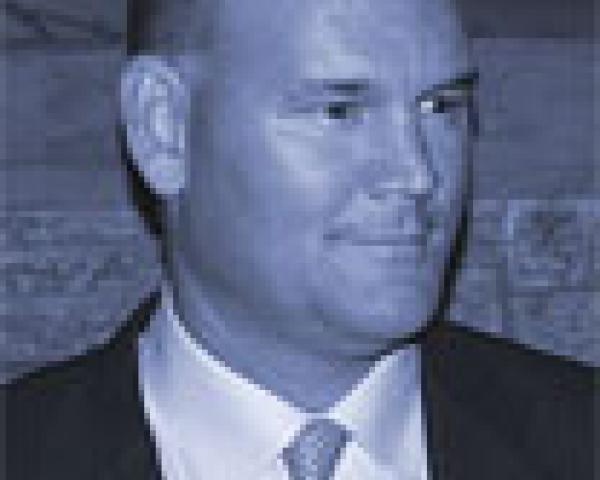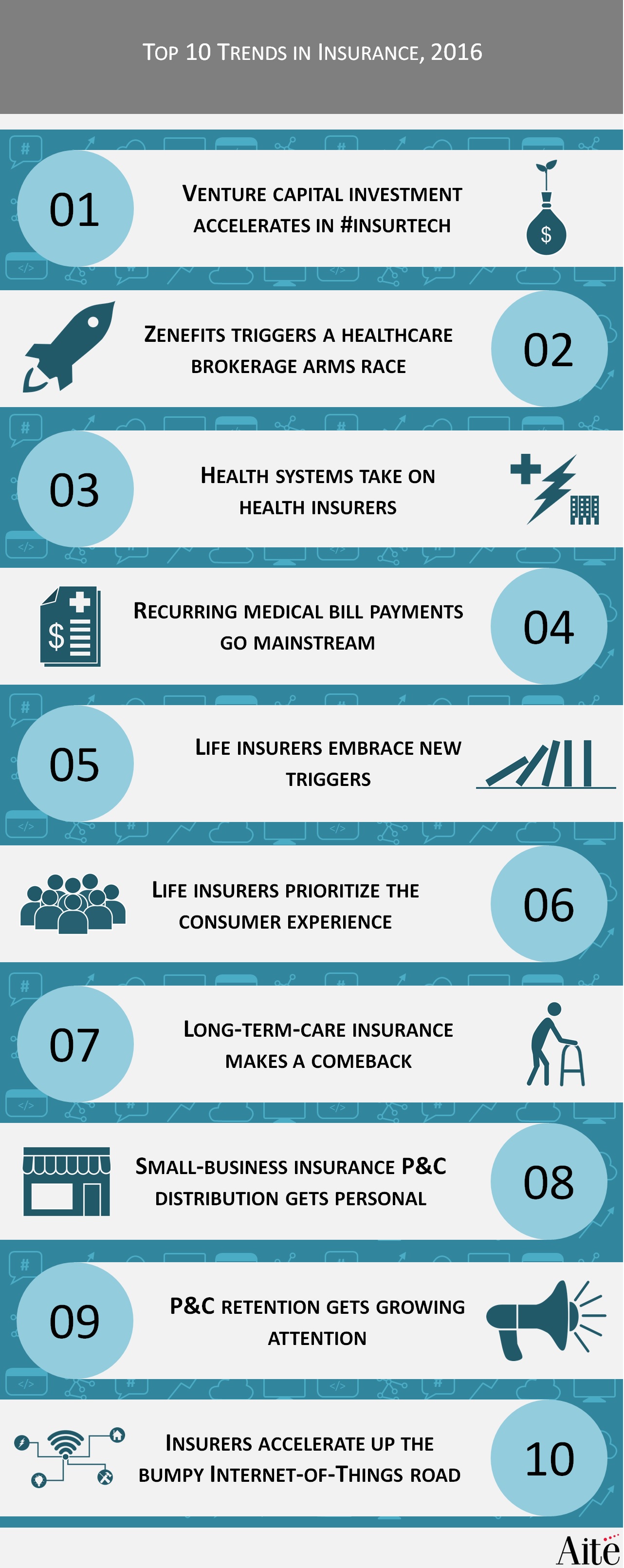Blockchain, blockchain, blockchain! What does that mean for insurance? No one knows yet, but that doesn’t stop blockchain from being one of the hottest topics in the insurance industry right now. This week, I take a look at the direction this puck is heading.
Hype or reality?
Last September, the World Economic Forum published a report titled,
Deep Shift – Technology Tipping Points and Societal Impact. The report is based on surveys with more than 800 executives and experts about new technologies and innovations. The point of the report is to identify deep shifts in society that result from new technologies. These include areas such as 3D printing, driverless cars, wearables and artificial intelligence.
I was drawn to shift No. 16, simply called “Bitcoin and the blockchain.” By 2025, 58% of these experts and executives believed we would hit the tipping point for Bitcoin and blockchain. This was defined as:
“10% of global gross domestic product will be stored on blockchain technology.”
To put that into context, the total worth of Bitcoin today in the blockchain is about 0.025% of today’s $80 trillion global GDP.
Also of interest, especially given that it looks like Tunisia will be
the first country to issue a digital currency on a blockchain, shift No. 18 was called “Governments and the blockchain.” Here, almost three out of four in the survey group expected that “governments would collect tax via a blockchain by 2023."
It’s a reality then!
It’s certainly looks that way. And $500 million of venture capital money in 2015 can’t be wrong, can it?
The prospect of a seismic shift on a par with the impact of the Internet is compelling. That explains all the attention, predictions and excitement about blockchain. But, if we use the evolution of the Internet as a benchmark, the development of blockchain today for commercial use is equivalent to the Internet in, say, the mid-1990s, at best.
The debates on Bitcoin, on whether private or public blockchains will be used, on Sybase vs Oracle (oops, wrong century) are yet to play out. The ability of the Bitcoin blockchain to scale to handle massive volumes at lightning speed remains unproven.
Now, just as it was in 1995, blockchain technology is at an embryonic stage. Still finding its way, it has yet to prove it is a viable, industrial-strength, large-scale technology capable of solving world hunger.
That is why I am going to focus on the use case for insurance rather than the technology itself. (For one explanation of how blockchain works, go to
Wired.)
The smart insurance contract
This is getting the most attention right now. The notion of automating the insurance policy once it is written into a smart contract is compelling. The idea that it will pay out against the insurable event without the policyholder having to a make a claim or the insurer having to administer the claim has significant attractions.
First, the cost of claims processing simply goes away. Second, the opportunity for fraud largely goes away, too. (I hesitate here simply because it is theoretical and not yet proven.) Third, customer satisfaction must go up!
One example being used to illustrate how these might work came from the
London Fintech Week Blockchain Hackathon last September. Here, a team called
InsurETH built a flight insurance product over a weekend on the
Ethereum platform.
The use case is simple. In the 12 months leading up to May 2015, there were 558,000 passengers who did not file claims for delayed or canceled flights in and out of the UK. In fact, fewer than 40% of passengers claimed money from their insurance policy.
InsurETH built a smart contract where the policy conditions were held on blockchain. Using the
Oraclize service to connect the blockchain with the Internet, publicly available data is used to trigger the insurance policy.
In this case, a delayed flight is a matter of fact and public record. It does not rely on anyone’s judgement or individual assessment. It is what it is. If a delayed flight occurs, the smart contract gets triggered, and the payout is made, automatically and immediately, with no claims processing costs for the insurer and to the satisfaction of the customer.
Building on this example and applying it to motor, smart contracts offer a solution for insurers to control claims costs after an accident. A trigger that there has been an accident would come to the blockchain via the Internet from a smartphone app or a connected car. Insurers are always frustrated when customers go a more expensive route for repairs, recovery and car hire. So, with a smart contract, insurers could code the policy conditions to only pay out to the designated third parties (see
related article by Sia Partners).
So long as the policy conditions are clear and unambiguous and the conditions for paying are objective, insurance can be written in a smart contract. When the conditions are undeniably reached, the smart contract pays. As blockchain startup
SmartContract put it, “Any data feed trusted by a counterparty to release payment or simply complete an agreement can power a smart contract.”
To understand this better, I asked
Joshua Davis, the technical architect and co-founder at blockchain p2p InsurTech
Dynamis, to explain. He said:
“You need well-qualified oracle(s) to establish what 'conditions' exist in the real world and when they have been 'undeniably reached.' An oracle is a bridge between the blockchain and the current state of places, people and things in the real world. Without qualified oracles, there can be no insurance that has any relation to the world that we live in.
“As far as oracles go, you can use either a single trusted oracle, who puts up a large escrow that is lost if they feed you misinformation, or many different oracles who don’t rely on the same POV [point of view] or data sources to verify that events occurred.
“In the future, social networks will be the cheapest and most used decentralized data feeds for various different insurance applications. Our social networks will validate and verify our statements as lies or facts. We need to be able to reliably contact a large enough segment of a claimant’s social network to obtain the truth. If the insurance policy can monitor the publishing or notification of our current status to these participants and their responses accurately confirm it, then social networks will make for the cheapest, most reliable oracles for all types of future claims validation efforts.”
Is this simply too good to be true?
Personally, I don’t think it is. Of course, a smart contract doesn’t have to be on the blockchain to deliver this use case.
However, what the blockchain offers is trust. And it offers provenance. The blockchain provides an immutable record and audit trail of an agreement. The policyholder does not have to rely on the insurer’s decision to pay damages because the insurer has broken its promise to keep the client safe from harm. As the WEF report states, this is an “unbreakable escrow.” The insurer will pay before it even knows what happened.
There’s another reason for going with the blockchain: cybersecurity!
With the blockchain sitting outside the corporate firewall and being managed by many different and unconnected parties, the cyber criminal no longer has a single target to attack. As far as I’m aware, blockchain is immune to all of the conventional cyber threats that corporations are scared of.
What happens when you put blockchain and P2P insurance together?
In December, I published a two-part article on Peer 2 Peer Insurance (here are
Part 1 and
Part 2). When you put the P2P model together with the blockchain, this creates the potential for a near-autonomous, self-regulated insurance business model for managing policy and claims.
Last year, Joshua Davis wrote an interesting white paper called
“Peer to Peer Insurance on the Ethereum Blockchain." He presents the theory behind blockchain and the creation of decentralized autonomous organizations (DAO). These are corporate entities with no human employees.
The DAOs would be created for groups of policyholders, similar to the P2P group model with the likes of Guevara and Friendsurance. No single body or organization would control the DAO; it would be equally “controlled” by policyholders within each group. All premiums paid would create a pool of capital to pay claims.
And because this is a self-governing group with little or no overhead, any float at the end of the year would be distributed back among the policyholders. Arguably, this makes the DAO a non-profit organization and materially increases the capital reserve for claims costs.
The big question mark for this model is regulation. There still is no answer to who will maintain the blockchain code within each DAO when regulations change. But, what does seem a dead certainty is that someone, somewhere is figuring out how to solve this.
Blockchain offers the potential for new products and services in a P2P insurance model. It should also open insurance to new markets, especially those on or near the poverty line.
For now, we must watch to see what comes from the likes of
Dynamis, which is using smart contracts to provide supplementary employment insurance cover on Ethereum.
Innovation will come from new players
It has been my belief for some time that, in the main, incumbent insurance firms will not be able to materially innovate from within. As with Fintech, the innovation that will radically change this industry will come from new entrants and start-up players, such as:
Dynamis
SmartContract
Rootstock
Everledger (see previous article on
Daily Fintech)
Tradle
Ethereum Frontier
Codius (Ripple Labs) (update: Codius
discontinued)
This is particularly true with blockchain in insurance. These new age pioneers are unencumbered by corporate process, finance committees, bureaucracy and organizational resistance to change.
Besides, the incumbent insurance CIOs have heard this all before. For decades, software vendors have promised nirvana with new policy administration, claims and product engines. So, why should they listen to the claims that blockchain is the panacea for their legacy IT issues? But, that is a subject for another post … watch this space!
 Agencies and brokerages should also consider that the next generation of tech-savvy insurance consumers will also be the next wave of insurance employees. They bring a new set of expectations to the workplace as insurance professionals from the baby boomer generation begin to retire.
Delivering a digital customer experience has become table stakes for the next-generation trusted adviser. The insurance experience of yesterday is no longer sufficient with today's demands and tomorrow's expectations.
Agencies and brokerages should also consider that the next generation of tech-savvy insurance consumers will also be the next wave of insurance employees. They bring a new set of expectations to the workplace as insurance professionals from the baby boomer generation begin to retire.
Delivering a digital customer experience has become table stakes for the next-generation trusted adviser. The insurance experience of yesterday is no longer sufficient with today's demands and tomorrow's expectations.
 Advanced software, such as Applied Epic, delivers pre-built, best-practice workflows to streamline processes and reduce time spent on duplicate tasks. Additionally, end-to-end transactions between a business and insurers need to happen within the management system for optimal productivity and efficient business operations. For agents using IVANS Download, employees save an average of two hours per employee per day.
The Makings of a Digital Agency or Brokerage
Digital transformation reflects the transition of taking manual, paper-filled processes to digitally automated workflows powered by software and the Internet. A "digital agency" is one that has undergone a digital transformation to drive growth and profitability across its lines of business. It experiences many digital, paperless interactions and transactions per day with insurers and insureds and among staff.
A digital agency is built on 5 pillars:
Advanced software, such as Applied Epic, delivers pre-built, best-practice workflows to streamline processes and reduce time spent on duplicate tasks. Additionally, end-to-end transactions between a business and insurers need to happen within the management system for optimal productivity and efficient business operations. For agents using IVANS Download, employees save an average of two hours per employee per day.
The Makings of a Digital Agency or Brokerage
Digital transformation reflects the transition of taking manual, paper-filled processes to digitally automated workflows powered by software and the Internet. A "digital agency" is one that has undergone a digital transformation to drive growth and profitability across its lines of business. It experiences many digital, paperless interactions and transactions per day with insurers and insureds and among staff.
A digital agency is built on 5 pillars:










 Cyber threats and elections– Threat actors targeted the websites and emails of presidential candidates in 2008 and 2012. Campaign websites continue to be used to raise money, making them targets for hacktivists and cyber criminals alike. Expect to see U.S. primary frontrunners and eventual nominees successfully targeted and to see at least one campaign undermined by a data breach.
IoT spurs new rules– This will be the year consumers awaken to security and privacy concerns attendant to the Internet of Things. A major physical disruption — through the breach of a connected car or medical device or weak security in a connected toy — will spur regulators and consumers to demand action. Expect companies to spend untold amounts on testing and retrofitting IoT devices to meet hastily approved “privacy and security by design” rules.
Insider threats get addressed– Insider threats — current or ex-employees with knowledge of, and access to, the corporate network — will take center stage in 2016. This will push human resources leaders onto cross-functional cybersecurity teams in many organizations. Expect leading-edge companies to invest in technologies that identify and, in some cases, prevent insider threats before they cause material damage.
International data flows narrow– Uncertainty arising from the demise of the EU-U.S. Safe Harbor pact will disrupt international data flows. Expanding European nationalism, distrust of U.S. surveillance and subpoena power, the prospect of triggering huge fines for transborder transfers and political disputes over alternatives will drive some U.S. companies to avoid doing business with Europe altogether. Meanwhile, other multinationals will opt to segregate business functions geographically by building local cloud services and data centers that protect them from penalties.
Boardroom shuffle– With concern mounting over cyber risks, organizations will evaluate fresh approaches to ensure boards are well-informed and comfortable making strategic decisions. Expect the appointment of specialist, non-executive cyber directors and the formation of dedicated cyber-risk committees (similar to audit committees) with independent advisers. Regulators may also pursue the concept of “cyber competent” people as a requirement for boards.
Cyber insurance spike– Demand for cyber liability coverage will continue to rise. Expect premiums to also rise because of constantly evolving threats, immature risk models and an underdeveloped reinsurance market. This will affect retailers, healthcare providers, banks and others that are considered high risk. Uncertainty about the concentration of exposure will lead regulators to impose cyber incident “stress testing.” This is a way to model the impact of multiple, simultaneous incidents on cyber insurance carriers — and potentially stop those that fail these tests from writing new policies.
Cyber threats and elections– Threat actors targeted the websites and emails of presidential candidates in 2008 and 2012. Campaign websites continue to be used to raise money, making them targets for hacktivists and cyber criminals alike. Expect to see U.S. primary frontrunners and eventual nominees successfully targeted and to see at least one campaign undermined by a data breach.
IoT spurs new rules– This will be the year consumers awaken to security and privacy concerns attendant to the Internet of Things. A major physical disruption — through the breach of a connected car or medical device or weak security in a connected toy — will spur regulators and consumers to demand action. Expect companies to spend untold amounts on testing and retrofitting IoT devices to meet hastily approved “privacy and security by design” rules.
Insider threats get addressed– Insider threats — current or ex-employees with knowledge of, and access to, the corporate network — will take center stage in 2016. This will push human resources leaders onto cross-functional cybersecurity teams in many organizations. Expect leading-edge companies to invest in technologies that identify and, in some cases, prevent insider threats before they cause material damage.
International data flows narrow– Uncertainty arising from the demise of the EU-U.S. Safe Harbor pact will disrupt international data flows. Expanding European nationalism, distrust of U.S. surveillance and subpoena power, the prospect of triggering huge fines for transborder transfers and political disputes over alternatives will drive some U.S. companies to avoid doing business with Europe altogether. Meanwhile, other multinationals will opt to segregate business functions geographically by building local cloud services and data centers that protect them from penalties.
Boardroom shuffle– With concern mounting over cyber risks, organizations will evaluate fresh approaches to ensure boards are well-informed and comfortable making strategic decisions. Expect the appointment of specialist, non-executive cyber directors and the formation of dedicated cyber-risk committees (similar to audit committees) with independent advisers. Regulators may also pursue the concept of “cyber competent” people as a requirement for boards.
Cyber insurance spike– Demand for cyber liability coverage will continue to rise. Expect premiums to also rise because of constantly evolving threats, immature risk models and an underdeveloped reinsurance market. This will affect retailers, healthcare providers, banks and others that are considered high risk. Uncertainty about the concentration of exposure will lead regulators to impose cyber incident “stress testing.” This is a way to model the impact of multiple, simultaneous incidents on cyber insurance carriers — and potentially stop those that fail these tests from writing new policies.









